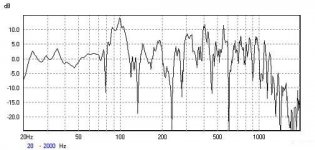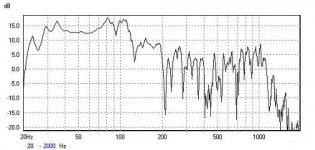Hi Simon,
I didn't express myself very well I'm afraid! Sorry for the confusion. What I meant to say was that a structure intended as an absorber could resonate and produce an audible sound of it's own if not properly constructed. Re-radiated not reflected!
Your comments and the follow up by Shin are exactly right....
Cheers, Ralph
I didn't express myself very well I'm afraid! Sorry for the confusion. What I meant to say was that a structure intended as an absorber could resonate and produce an audible sound of it's own if not properly constructed. Re-radiated not reflected!
Your comments and the follow up by Shin are exactly right....
Cheers, Ralph
Hi Shin,
Whilst bass traps are the ideal solution to resonaces caused room modes, EQ is almost as good in my experience. There are plenty of great sounding rooms that don't use bass traps.
I think the key to bass control is firstly and most importantly the placement of the subs. With correct placement the problems that severe room modes create are never felt, or at least felt to a lesser degree. After the placement, EQ can be used to smooth out the remaining peaks.
As Toole points out (ref 1), room resonance at low frequencies is a minimum phase phenomenon and so is ammenable to correction with EQ. The before-and-after transient response plots Toole shows are a testament to this fact.
Bass traps achieve the same end as EQ and have the added benefit of making the room acoustically larger by increasing the low frequency reverberation time. But EQ is nearly as good and lot less hassle.
When you speak about eliminating EQ above 300Hz or so, I'm assuming you're speaking about room EQ? Your intuition is correct about not being able to effectively EQ a room for resonant behaviour higher up than 100-200Hz. The room modes become too dense and their behaviour becomes more like reverberation. The point at which the transition occurs is the Schroeder frequency (ref2). Above the Schroeder frequency reverberation control is best handled by acoustic aids such as absorbers and diffusors.
As Simon suggests, absorbers placed on boundaries near the ear and diffusors placed on boundaries far away from the ear are going to be the best starting point.
When considering absorbers, keep in mind the absorption that's already present in the form of wall construction and furnishings. You may already have plenty of absorption within certain frequency ranges. Tables of absorption coefficients can be used for calculations, or you can measure the RT60 within various frequency bands directly.
Ref 1: Loudspeakers and Rooms for Multichannel Audio Reproduction - part 3. Floyd Toole. Page 17.
Ref2: http://www.linkwitzlab.com/rooms.htm
Cheers, Ralph
Whilst bass traps are the ideal solution to resonaces caused room modes, EQ is almost as good in my experience. There are plenty of great sounding rooms that don't use bass traps.
I think the key to bass control is firstly and most importantly the placement of the subs. With correct placement the problems that severe room modes create are never felt, or at least felt to a lesser degree. After the placement, EQ can be used to smooth out the remaining peaks.
As Toole points out (ref 1), room resonance at low frequencies is a minimum phase phenomenon and so is ammenable to correction with EQ. The before-and-after transient response plots Toole shows are a testament to this fact.
Bass traps achieve the same end as EQ and have the added benefit of making the room acoustically larger by increasing the low frequency reverberation time. But EQ is nearly as good and lot less hassle.
When you speak about eliminating EQ above 300Hz or so, I'm assuming you're speaking about room EQ? Your intuition is correct about not being able to effectively EQ a room for resonant behaviour higher up than 100-200Hz. The room modes become too dense and their behaviour becomes more like reverberation. The point at which the transition occurs is the Schroeder frequency (ref2). Above the Schroeder frequency reverberation control is best handled by acoustic aids such as absorbers and diffusors.
As Simon suggests, absorbers placed on boundaries near the ear and diffusors placed on boundaries far away from the ear are going to be the best starting point.
When considering absorbers, keep in mind the absorption that's already present in the form of wall construction and furnishings. You may already have plenty of absorption within certain frequency ranges. Tables of absorption coefficients can be used for calculations, or you can measure the RT60 within various frequency bands directly.
Ref 1: Loudspeakers and Rooms for Multichannel Audio Reproduction - part 3. Floyd Toole. Page 17.
Ref2: http://www.linkwitzlab.com/rooms.htm
Cheers, Ralph
ralphs99 said:
Bass traps achieve the same end as EQ and have the added benefit of making the room acoustically larger by increasing the low frequency reverberation time. But EQ is nearly as good and lot less hassle.
Bass traps decrese the LF reverberation time (decay rate).
I find they do help give tighter bass, where as EQ just evens the response out. But you are right that with careful placement and EQ you can get extremely good results still.
Here's the amplitude response in my listening room with no EQ and 2 subs, one each along the mid point of two opposing walls. No low frequency absorption is fitted to the room for these experiments.
Very flat apart from a sharp dip at about 78Hz and then multiples there of, along with a large-ish peak (15dB) at 100Hz.
(Ignore the response above 150Hz. I think I set the upper cut-off frequency at 1kHz)
Very flat apart from a sharp dip at about 78Hz and then multiples there of, along with a large-ish peak (15dB) at 100Hz.
(Ignore the response above 150Hz. I think I set the upper cut-off frequency at 1kHz)
Attachments
With just a simple 2nd order bass boost at 53Hz and a small change to the position of the subs along the wall, the following amplitude response results.
About +/-3dB from 30Hz to 120Hz....
Note that there is no smoothing at all in these plots.
Cheers, Ralph
About +/-3dB from 30Hz to 120Hz....
Note that there is no smoothing at all in these plots.
Cheers, Ralph
Attachments
I'm starting to get together firm idea's for a ceiling absober/diffusor.
I've got a couple of options:
10cm thick open cell foam with overall dimesions of 228cm x 115cm. This will stand off from the ceiling by around 10-15cm.
15cm thick open cell foam with overall dimensions of 155cm x 115cm and again will stand off by around 10-15cm.
Which would be the better proposition?
I was also thinking that I could perhaps turn it into a gaint bass trap by going to say 20cm thick foam. Would that even work?
I've got a couple of options:
10cm thick open cell foam with overall dimesions of 228cm x 115cm. This will stand off from the ceiling by around 10-15cm.
15cm thick open cell foam with overall dimensions of 155cm x 115cm and again will stand off by around 10-15cm.
Which would be the better proposition?
I was also thinking that I could perhaps turn it into a gaint bass trap by going to say 20cm thick foam. Would that even work?
Hi Shin,
I think the 288cm x 115cm is the right way to go. In either case, if you are wanting to control the reverberation characteristics of the room and/or if you wish to minimise the ceiling reflection, the larger area of the bigger absorber will be more effective.
Doubling the depth of the absorber will improve it's low frequency extension by one octave. So going from a total depth of 20-25cm to a total depth of 25-30cm will make very little difference in performance. With these thicknesses the absorber should effective down to about 100Hz.
In order to make a bass trap the air volume needs to be contained. The resonance frequency of the air volume is then controlled by the dimensions and port(s) size.
There's an excellent Dutch page devoted to Helmholtz (bass traps) and other absorbers at http://www.mhsoft.nl/Helmholtzabsorber.asp
Of particular interest in your case is the ceiling mounted Slot Helmholtz Resonator. This can be made into a broadband device operating down to around 200Hz as a resonator and even lower if foam stuffing is used.
For a true bass trap, ie a helmholtz resonator tuned to a specific frequency, you obviously need to know the frequency of the troublesome room mode and need to also place the resonator where the particular room mode has a velocity maxima.
Cheers, Ralph
I think the 288cm x 115cm is the right way to go. In either case, if you are wanting to control the reverberation characteristics of the room and/or if you wish to minimise the ceiling reflection, the larger area of the bigger absorber will be more effective.
Doubling the depth of the absorber will improve it's low frequency extension by one octave. So going from a total depth of 20-25cm to a total depth of 25-30cm will make very little difference in performance. With these thicknesses the absorber should effective down to about 100Hz.
In order to make a bass trap the air volume needs to be contained. The resonance frequency of the air volume is then controlled by the dimensions and port(s) size.
There's an excellent Dutch page devoted to Helmholtz (bass traps) and other absorbers at http://www.mhsoft.nl/Helmholtzabsorber.asp
Of particular interest in your case is the ceiling mounted Slot Helmholtz Resonator. This can be made into a broadband device operating down to around 200Hz as a resonator and even lower if foam stuffing is used.
For a true bass trap, ie a helmholtz resonator tuned to a specific frequency, you obviously need to know the frequency of the troublesome room mode and need to also place the resonator where the particular room mode has a velocity maxima.
Cheers, Ralph
- Status
- This old topic is closed. If you want to reopen this topic, contact a moderator using the "Report Post" button.
- Home
- Loudspeakers
- Multi-Way
- Aeropanel acoustic absorber

